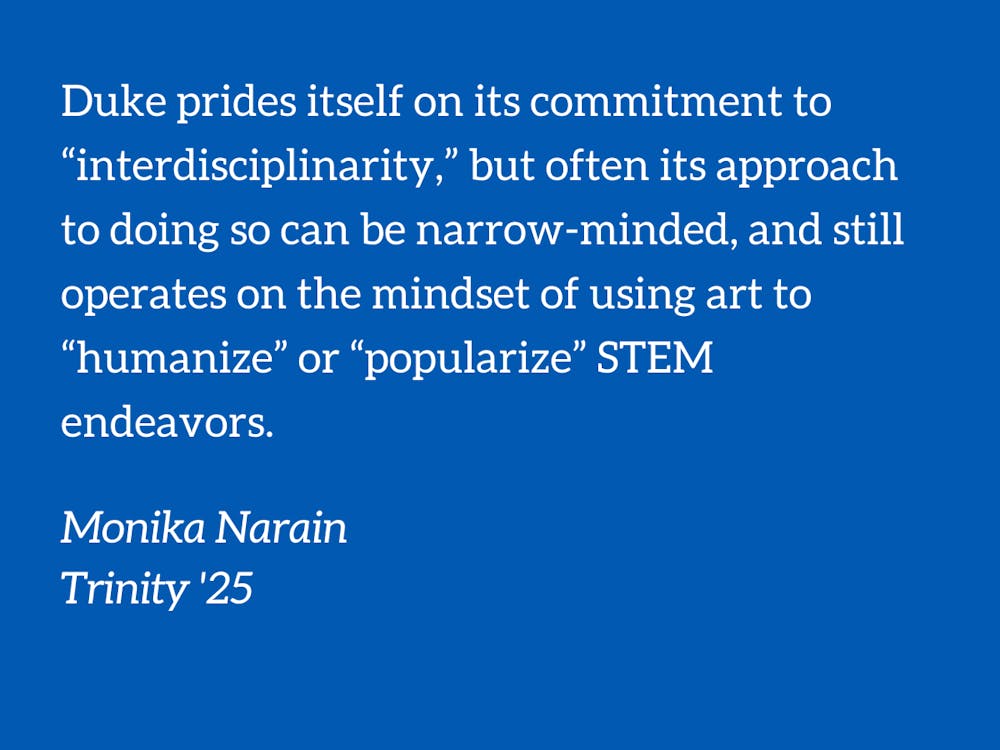This past semester, I participated in the Laboratory Art in Practice: Building a Model for the Art/Science Lab at Duke Bass Connections team.
Now, that title has a lot of words, and within it a lot of hefty goals. Multiple universities have founded new Art/Science working groups, labs, and even full institutes dedicated to the advancement of this interdisciplinary space (or maybe disciplinary interspace?), a colorful gray area between two monolithic fields of thought. Art/Science embodies a rich diversity of practices, media, and theoretical frameworks, and we’re in the midst of a massive movement of art-scientists, science-artists, or some other linear combination of the two, developing all sorts of novel creations that far exceed the length of any singular article.
Truthfully, if you asked me what I did for 2.5 hours every Friday this semester, I’d struggle to give you a good answer. Yes, I took an Art/Science class, but you’d probably ask, what does that even look like? Does it look like staining agar plates with various bacteria to make paintings with a sequenceable genome? Reading science fiction short stories, nonsense poems, or books by Bill Nye the Science Guy? Talking to various people who do artsy or science-y or artsy-science-y things? Or maybe it’s none of those at all, and for 12 weeks we instead engaged in rigorous debate about the positives and negatives of Art vs. Science - by which I mean, of course, the famous Australian electronic dance band.
But then I’d say you’re not really asking the right question. Sure, we covered, created, and contested a great deal, but we also barely scratched the surface of what Art/Science can be, let alone established an official lab space for its study. We still don’t have a real lab space; in fact, we still don’t really know what constitutes a “lab” versus a bunch of people screwing around in the Bio202 classroom.
I think what was most important about this class was not what it instructed, but what it represented. It was not about trying to make pretty microscope images from dissected fruit fly ovaries (although that did happen), but about creating a space where students can harmonize their scientific and artistic interests, or explore new creative processes entirely. It was a space where artists could learn science and scientists could learn art in a way that was non-judgemental and epitomized the sense of curiosity that characterizes both fields. Where one can think critically about what it means to conduct “research,” devise an “experiment,” or work in a “lab,” and consequently envision alternate methods of teaching, communicating, or learning in either field.
Again, all of these grand idealisms do not deter from the fact that most of the work I produced was of pretty low-grade quality, and much of the course’s best-laid plans fell to the whims of post-pandemic logistical fiascos. I still don’t really know what the end result of this project will be; four months in I find myself even more confused. I could write pages on the stark dichotomies between the management strategies of science vs. art classrooms and labs. I could write an entire opinion article about our campus’s overwhelming STEM superiority culture that debases the arts to the “elective,” the “easy class,” the “release” from the grueling monotony and rigor of a STEM degree. But this only reinforces the ever-puzzling question of how to blend these two opposing institutional systems to build a sustainable Art/Science space at Duke, where both science and art can be taken equally seriously.
Last year, one of my teachers called me “intellectually undisciplined,” and while I initially was offended by the statement, I don’t take much offense to it anymore. Duke prides itself on its commitment to “interdisciplinarity,” but often its approach to doing so can be narrow-minded, and still operates on the mindset of using art to “humanize” or “popularize” STEM endeavors. For example, previous and current Bass projects center around topics like art/music therapies for dementia patients or medical anthropology/humanities courses. But it rarely works in reverse, where STEM is used to improve artistic work, although I do think that culture is slowly changing, especially in the computational media sector.
Sometimes, it’s not enough to work at the intersection between a select few academic subjects, the bridge connecting distant islands. Sometimes, the things you are truly passionate about may not even partially reside in one of these islands altogether, and that’s totally okay. Sometimes rather than building bridges (no offense civil engineers), it may be more beneficial to navigate on a boat, to explore not only what lies between these disciplines but also what lies around and beyond each academic field in this rich, vast ocean known as the Duke Endowment. Sometimes, you have to get the lay of both lands if you want to build stronger, more inclusive ones, and reimagine what it means to learn effectively at Duke. Sometimes, you have to be a little intellectually undisciplined.
Monika Narain is a Trinity sophomore. Her columns typically run on alternate Fridays.
Get The Chronicle straight to your inbox
Signup for our weekly newsletter. Cancel at any time.

